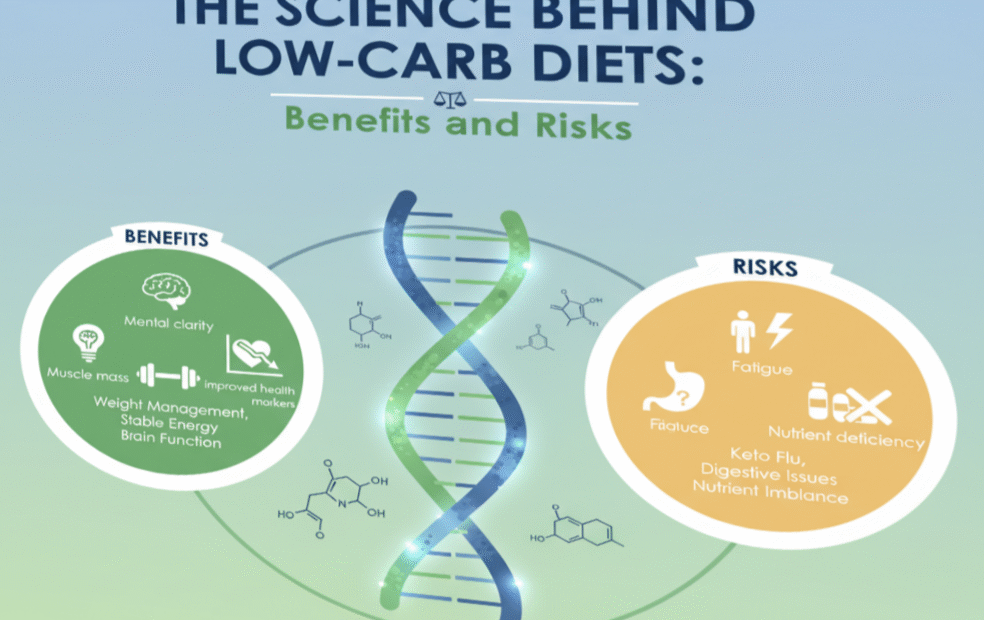Low-carb diets have become one of the most popular nutrition strategies in recent years. From the classic Atkins diet to modern approaches like the ketogenic diet, millions of people are cutting carbs in hopes of losing weight, controlling blood sugar, and improving overall health. But what does science actually say about low-carb diets? In this article, we’ll break down the benefits and risks of low-carb eating so you can make an informed decision in 2025.
What Is a Low-Carb Diet?
A low-carb diet is a way of eating that reduces the intake of carbohydrates—foods such as bread, pasta, rice, and sugary snacks—while emphasizing protein, healthy fats, and vegetables. Typically, people on low-carb diets consume anywhere from 20 to 100 grams of carbs per day, depending on their goals and the specific plan they follow.
The Science: How Do Low-Carb Diets Work?
Carbohydrates are the body’s primary source of energy. When you cut carbs, your body turns to stored fat for fuel, a process called ketosis. This metabolic shift is the reason low-carb diets are often linked to faster weight loss, improved blood sugar control, and reduced appetite.
- Insulin regulation: Fewer carbs mean less insulin production, which may reduce fat storage.
- Satiety: Protein and fat keep you full longer, reducing overall calorie intake.
- Metabolic flexibility: The body adapts to burning fat as its main energy source.
Benefits of Low-Carb Diets
1. Effective for Weight Loss
Multiple studies show that low-carb diets can help people lose weight more effectively than traditional low-fat diets, especially in the short term. By reducing cravings and increasing fat burning, many people find it easier to maintain a calorie deficit.
2. Improved Blood Sugar and Insulin Sensitivity
Low-carb diets are particularly beneficial for people with type 2 diabetes or prediabetes. By cutting down on carbs, blood sugar spikes are reduced, and insulin sensitivity often improves.
3. Better Heart Health Markers
Some research suggests that low-carb diets can lower triglycerides and increase HDL cholesterol, both of which are linked to a reduced risk of heart disease.
4. Appetite Control
Unlike low-calorie diets that often leave you hungry, low-carb diets emphasize protein and fat, which are more satisfying. This leads to reduced snacking and easier portion control.
Risks and Potential Downsides of Low-Carb Diets
1. Nutrient Deficiencies
By cutting out whole grains, fruits, and certain vegetables, you may miss out on essential vitamins, minerals, and fiber.
2. Digestive Issues
A lack of dietary fiber can lead to constipation and other gut health problems. Balancing low-carb eating with high-fiber vegetables is important.
3. Keto Flu
When switching to a very low-carb diet, some people experience fatigue, headaches, and irritability—often called the “keto flu.” These symptoms usually improve after a few days or weeks.
4. Long-Term Safety Concerns
While short-term results are promising, the long-term effects of very low-carb diets are still being studied. Some experts worry about potential impacts on kidney function, bone health, and overall sustainability.
Who Should Consider a Low-Carb Diet?
A low-carb diet may be a good fit for:
- Individuals seeking rapid weight loss.
- People with insulin resistance or type 2 diabetes.
- Those who prefer protein- and fat-based meals over carb-heavy foods.
However, it may not be suitable for athletes, pregnant women, or people with certain health conditions unless supervised by a healthcare provider.
Tips for Following a Low-Carb Diet Safely
- Focus on whole foods like lean meats, fish, eggs, nuts, seeds, and non-starchy vegetables.
- Include fiber-rich foods such as leafy greens, chia seeds, and flaxseed to support digestion.
- Stay hydrated and replenish electrolytes to minimize side effects.
- Consult a doctor or nutritionist before starting, especially if you have underlying health issues.
Conclusion
Low-carb diets can be highly effective for weight loss and blood sugar control, but they’re not without risks. The key is balance: choose nutrient-dense, whole foods while keeping carbs at a level that supports your lifestyle and health needs. If you’re considering a low-carb diet in 2025, weigh both the benefits and potential drawbacks to decide whether this approach is right for you.









